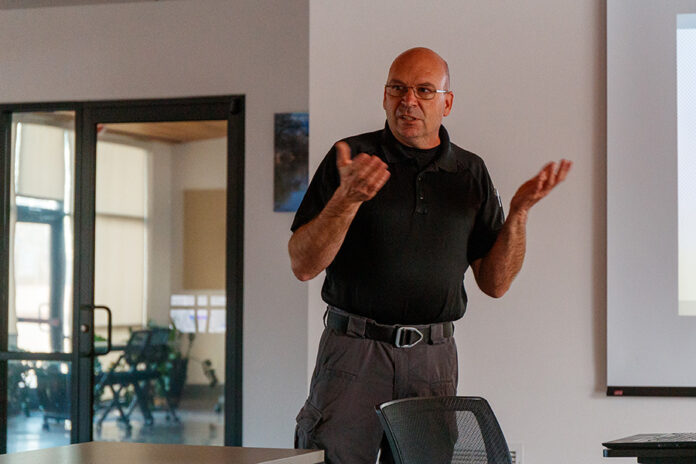The Cottonwood Police and Community Development departments hosted a joint community safety information night on Wednesday, March 29, to share tips on carbon monoxide and home security.
“The goals of these events are to educate the community on various topics, meet staff and others in the community and having a better understanding of codes, laws and other procedures,” Anthony Apodaca, an ordinance enforcement officer for the city of Cottonwood, stated in a press release.
Cody Blazer, the city’s building official, presented safety tips on carbon monoxide in households. Blazer argued that carbon monoxide poisoning can pose a fatal threat, especially when appliances are installed incorrectly or are not properly ventilated.
He shared that a family of four in Cottonwood were recently hospitalized from carbon monoxide poisoning, and also referred to stories he’d heard of deaths caused by an improperly-installed furnace and an incorrectly vented water heater. People are usually at higher risk of carbon monoxide poisoning in colder weather.
Carbon monoxide is sometimes called a silent killer, as it is a tasteless, colorless and odorless gas. When inhaled, the body preferentially absorbs carbon monoxide rather than oxygen, depriving cells of the oxygen they need.
Signs of carbon monoxide poisoning can include headache, dizziness, weakness, vomiting, chest pain, confusion and flu-like symptoms. If a houseful of people all show similar symptoms, the cause may be carbon monoxide poisoning. Common sources of carbon monoxide include products of combustion, such as vehicle exhaust and incorrectly vented appliances.
Blazer argued that having a carbon monoxide detector is the easiest and most important method of preventing carbon monoxide poisoning. He also claimed that residents should service their appliances, never run a vehicle inside a garage and hire licensed contractors to install new and replaced appliances.
Clint Dobrinski, the Cottonwood Police Department’s training officer, discussed home security and ways to create an environment that is not conducive to crime. Dobrinski claimed that the biggest hurdle to get over when it comes to security is the belief that “that won’t happen here,” followed by paranoia. He argued that residents should find a balance between confidence and paranoia rather than rejecting paranoia outright as an acceptable motivation for behavior.
Dobrinksi suggested a number of measures residents can take around their homes to prepare for the unlikeliest of events, which he sorted into active and passive.
Active security measures, Dobrinski argued, perform a task and reduce the opportunity for a breach of the law. These include alarm systems, motion lights, animals and security guards.
He described how alarm systems can range from basic to complex and are very common now, with many households using systems such as Ring or Nest that can be remotely monitored. They often have video components and can alert homeowners based on motion or other triggers such as sound or heat. Motion lights, Dobrinski said, are inexpensive, and pets may alert their owners if something is different or if an intruder is present.
Passive security measures, according to Dobrinski, are features or design elements that reduce opportunity for a breach of the law but do not require batteries or other active upkeep. These include landscape features, architecture, construction and constant-on lighting.
Constant-on lighting is easy to install, Dobrinski claimed, but it costs money to run lights 24/7 and such lights are vulnerable to human error, as they only work if homeowners remember to turn them on. They are also a potential way to make one’s routine and habits more apparent to theoretically-watching criminals.
Dobrinski also addressed fencing, claimed that fences should not be easily climbable and lack foot and hand holds and speculated that homes with grass yards were less safe because it is more difficult to hear someone walking on grass than on concrete or gravel. He argued that “a little bit of cactus goes a long way,” showing an image of a window shielded by a large prickly cactus.
Elements of construction applicable to security that Dobrinski covered included how many windows a home has and how close to the ground they are. He did not recommend metal-barred security windows because they can block a potential exit in case of a fire. He did recommend window coverings to make it more difficult for potential criminals to see inside homes.
Dobrinski concluded with the routine advice that homeowners should always lock their doors and windows, be mindful of those around them, have situational awareness and pay attention to what is happening in their neighborhoods.



